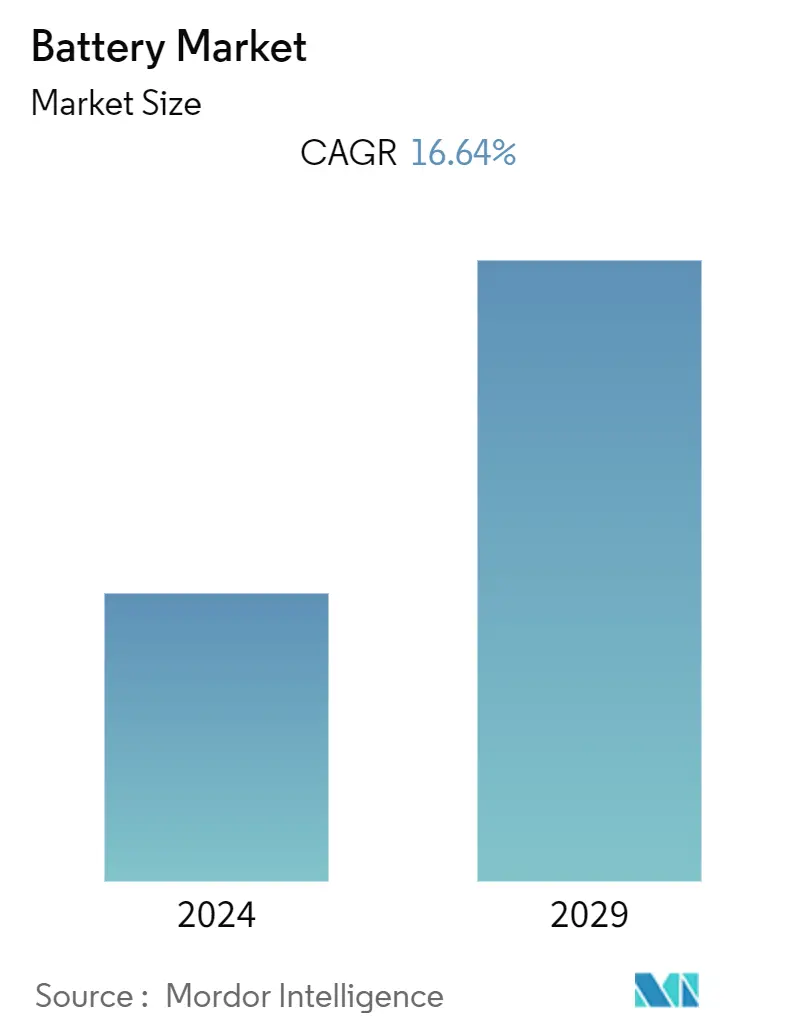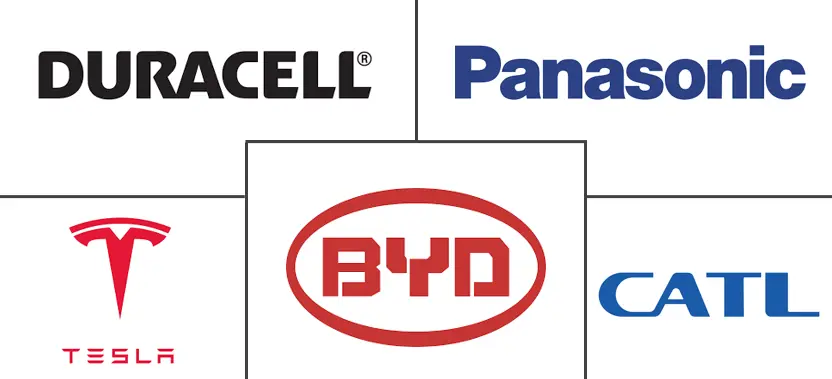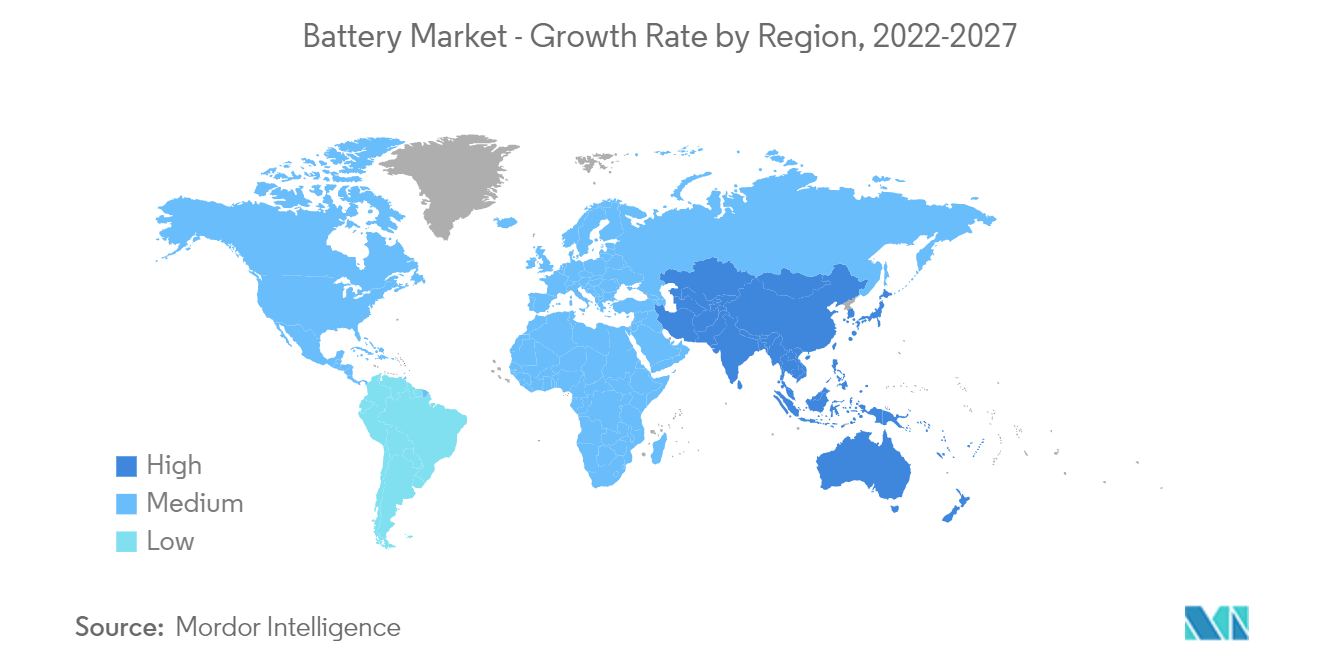Battery Market Size

| Study Period | 2020 - 2029 |
| Base Year For Estimation | 2023 |
| CAGR (2024 - 2029) | 16.64 % |
| Fastest Growing Market | Asia-Pacific |
| Largest Market | Asia-Pacific |
| Market Concentration | Low |
Major Players
*Disclaimer: Major Players sorted in no particular order |
Battery Market Analysis
The Battery Market is expected to register a CAGR of 16.64% during the forecast period.
The global battery market is estimated to reach a value of USD 132.44 billion by the end of this year.
The market was negatively impacted by COVID-19 in 2020. Currently, it has reached pre-pandemic levels.
- Over the long term, factors such as the declining lithium-ion battery prices and the growing usage of automotive batteries in electric vehicles are expected to drive the market.
- On the flip side, a mismatch in the demand and supply of raw materials for battery manufacturing is likely to hinder the market growth.
- As solar energy is an intermittent source and generates power only during the daytime, using off-grid solar power in conjunction with energy storage substantially enhances the utilization of solar PV units. As a result, energy storage with solar PV has been gaining popularity in developed countries, which is likely to create a huge opportunity for the battery market in the near future.
- Asia-Pacific is expected to dominate the battery market, with most of the demand coming from China, India, Japan, and South Korea.
Battery Market Trends
Automotive Batteries Expected to Witness Significant Growth
- Vehicles with internal combustion engine (ICE) technology were the only types preferred earlier. However, technology has now been shifting toward electric vehicles (EVs) due to growing environmental concerns. Lithium-ion batteries are predominantly used in EVs as they provide high energy density, low self-discharge, and low weight and require low maintenance.
- For ICE vehicles, lead-based batteries are being widely used. These batteries are expected to continue to be the only viable mass-market battery system for the foreseeable future. For SLI applications, lithium-ion batteries require heavy cost reductions to be considered a viable mass-market alternative to lead-based batteries.
- Lithium-ion battery systems propel plug-in hybrid and electric vehicles. These batteries contain the only available technology capable of meeting the OEM requirements for the vehicle's driving range and charging time. In 2021, the global stock of electric cars reached 16.49 million units, which increased by around 9% from 10.24 million units in 2020. This growth in EVs is expected to proped the demand for lithium-ion batteries as well.
- In January 2022, Nexeon Limited, a supplier of advanced silicon anode materials for next-generation lithium-ion batteries, licensed its NSP-1 technology to advanced material giant, SKC Co. Ltd. This contributed to the advancement of the research of automotive batteries.
- Also, in February 2022, Panasonic Corporation announced that its Energy Company will establish a production facility at its Wakayama Factory in western Japan to manufacture large cylindrical 4680 (46 mm wide and 80 mm tall) lithium-ion batteries for electric vehicles (EVs).
- Owing to the above-mentioned factors, the automotive batteries segment is expected to witness significant growth during the forecast period.

Asia-Pacific Expected to Dominate the Market
- Asia-Pacific has multiple growing economies with substantial natural and human resources. China and India are expected to be major investment hotspots for battery companies in the coming years because of policy-level support from the respective governments encouraging the manufacturing sector.
- The deployment of electric vehicles and the installation of renewable power plants in China and India are increasing rapidly, which is expected to create a massive demand for batteries.
- China is the largest market for electric vehicles (EVs), with over 1.15 million EVs sold in 2021. The country is expected to remain the world's largest electric car market. China accounted for almost 40% of the global sales of electric cars in 2021.
- Additionally, in January 2022, the 50% ownership rule was relaxed for passenger cars in China. Also, the laws restricting a foreign company from establishing more than two joint ventures producing similar vehicles in the country were removed.
- The Government of China is expected to cut down subsidies on electric vehicles by 30% in 2022 and eliminate it by the end of the year, as the electric vehicle industry in the country is now thriving. The planned subsidy cut is aimed at reducing the reliance of manufacturers on governmental funds for the development of new technologies and vehicles.
- India is also rapidly developing advanced batteries. As part of this, in June 2022, IIT Madras researchers developed a new kind of battery technology for electric cars. They developed mechanically-rechargeable zinc-air batteries, which are more economical than the existing lithium-ion batteries and have a longer shelf life. Zinc-air batteries can be used in two-wheeler and three-wheeler EVs.
- Therefore, owing to the above developments, Asia-Pacific is likely to remain the dominant region of the battery market, supported by the increasing urbanization and consumer spending across several countries, which is expected to ramp up the demand for technically advanced devices and vehicles due to the benefits provided by the same.

Battery Industry Overview
The global battery market is fragmented in nature. Some of the major players in the market (in no particular order) include Contemporary Amperex Technology Co. Limited, BYD Co. Ltd, Duracell Inc., Tesla Inc., and Panasonic Corporation.
Battery Market Leaders
-
Duracell Inc.
-
Panasonic Corporation
-
Contemporary Amperex Technology Co. Limited
-
BYD Co. Ltd
-
Tesla Inc.
*Disclaimer: Major Players sorted in no particular order

Battery Market News
- August 2022: Researchers at MIT developed a new concept for low-cost batteries, which are made entirely from abundant and inexpensive materials. The new battery architecture, which uses aluminum and sulfur as its two electrode materials and has a molten salt electrolyte in between, helps in providing low-cost backup storage for renewable energy sources.
- January 2022: BYD and FAW were planning a production facility for electric car batteries in northeastern China, with an annual capacity of 45 GWh. A joint venture between BYD and FAW, called FAW FinDreams New Energy Technology, was established with a registered capital of EUR 140 million. BYD holds 51% of the joint venture, and FAW Group owns the rest.
Battery Market Report - Table of Contents
1. INTRODUCTION
- 1.1 Scope of the Study
- 1.2 Study Assumptions
2. EXECUTIVE SUMMARY
3. RESEARCH METHODOLOGY
4. MARKET OVERVIEW
- 4.1 Introduction
- 4.2 Market Size and Demand Forecast in USD billion, till 2027
- 4.3 Battery/Raw Material Price Trends and Forecast, by Major Technology Type, till 2027
- 4.4 Import and Export Analysis in USD million, by Major Technology Type and Major Country, till 2021
- 4.5 Recent Trends and Developments
- 4.6 Government Policies and Regulations
-
4.7 Market Dynamics
- 4.7.1 Drivers
- 4.7.2 Restraints
- 4.8 Supply Chain Analysis
-
4.9 Porter's Five Forces Analysis
- 4.9.1 Bargaining Power of Suppliers
- 4.9.2 Bargaining Power of Consumers
- 4.9.3 Threat of New Entrants
- 4.9.4 Threat of Substitute Products and Services
- 4.9.5 Intensity of Competitive Rivalry
5. MARKET SEGMENTATION
-
5.1 Type
- 5.1.1 Primary Batteries
- 5.1.2 Secondary Batteries
-
5.2 Technology
- 5.2.1 Lead-acid Batteries
- 5.2.2 Lithium-ion Batteries
- 5.2.3 Nickel-metal Hydride (NiMH) Batteries
- 5.2.4 Nickel-cadmium (NiCD) Batteries
- 5.2.5 Nickel-zinc (NiZn) Batteries
- 5.2.6 Flow Batteries
- 5.2.7 Sodium-sulfur (NAS) Batteries
- 5.2.8 Zinc-manganese Dioxide Batteries
- 5.2.9 Small Sealed Lead-acid Batteries
- 5.2.10 Other Technologies (Dual Carbon Batteries, Zinc-carbon Batteries, Silver-oxide Batteries, etc.)
-
5.3 Application
- 5.3.1 Automotive Batteries (HEV, PHEV, and EV)
- 5.3.2 Industrial Batteries (Motive, Stationary (Telecom, UPS, Energy Storage Systems (ESS)), etc.)
- 5.3.3 Portable Batteries (Consumer Electronics, etc.)
- 5.3.4 Power Tool Batteries
- 5.3.5 SLI Batteries
- 5.3.6 Other Applications
-
5.4 Geography
- 5.4.1 North America
- 5.4.1.1 United States
- 5.4.1.2 Canada
- 5.4.1.3 Rest of North America
- 5.4.2 Asia-Pacific
- 5.4.2.1 China
- 5.4.2.2 India
- 5.4.2.3 Japan
- 5.4.2.4 South Korea
- 5.4.2.5 Rest of Asia-Pacific
- 5.4.3 Europe
- 5.4.3.1 Germany
- 5.4.3.2 France
- 5.4.3.3 Italy
- 5.4.3.4 United Kingdom
- 5.4.3.5 Russian Federation
- 5.4.3.6 Rest of Europe
- 5.4.4 South America
- 5.4.4.1 Brazil
- 5.4.4.2 Argentina
- 5.4.4.3 Rest of South America
- 5.4.5 Middle East & Africa
- 5.4.5.1 Saudi Arabia
- 5.4.5.2 United Arab Emirates
- 5.4.5.3 South Africa
- 5.4.5.4 Rest of Middle East and Africa
6. COMPETITIVE LANDSCAPE
- 6.1 Mergers and Acquisitions, Joint Ventures, Collaborations, and Agreements
- 6.2 Strategies Adopted by Leading Players
-
6.3 Company Profiles
- 6.3.1 BYD Co. Ltd
- 6.3.2 Contemporary Amperex Technology Co. Limited
- 6.3.3 Duracell Inc.
- 6.3.4 EnerSys
- 6.3.5 GS Yuasa Corporation
- 6.3.6 Clarios (Formerly Johnson Controls International PLC)
- 6.3.7 LG Chem Ltd
- 6.3.8 Panasonic Corporation
- 6.3.9 VARTA AG
- 6.3.10 Samsung SDI Co. Ltd
- 6.3.11 Tesla Inc.
- 6.3.12 TianJin Lishen Battery Joint-Stock Co. Ltd
- *List Not Exhaustive
7. MARKET OPPORTUNITIES AND FUTURE TRENDS
** Subject To AvailablityBattery Industry Segmentation
A battery is a device that converts chemical energy contained within its active materials directly into electric energy by means of an electrochemical oxidation-reduction (redox) reaction. The battery market is segmented by type, technology, application, and geography.
By type, the market is segmented into primary batteries and secondary batteries. By technology, the market is segmented into lead-acid batteries, lithium-ion batteries, nickel-metal hydride (NiMH) batteries, nickel-cadmium (NiCD) batteries, nickel-zinc (NiZn) batteries, flow batteries, sodium-sulfur (NAS) batteries, zinc-manganese dioxide batteries, small sealed lead-acid batteries, and other technologies (dual carbon batteries, zinc-carbon batteries, silver-oxide batteries, etc.). By application, the market is segmented into automotive batteries (HEV, PHEV, and EV), industrial batteries (motive, stationary (telecom, UPS, energy storage systems (ESS)), etc.), portable batteries (consumer electronics, etc.), power tool batteries, SLI batteries, and other applications. The report also covers the market size and forecasts for the battery market across major regions. For each segment, the market sizing and forecasts have been done on the basis of revenue (USD billion).
| Type | Primary Batteries | |
| Secondary Batteries | ||
| Technology | Lead-acid Batteries | |
| Lithium-ion Batteries | ||
| Nickel-metal Hydride (NiMH) Batteries | ||
| Nickel-cadmium (NiCD) Batteries | ||
| Nickel-zinc (NiZn) Batteries | ||
| Flow Batteries | ||
| Sodium-sulfur (NAS) Batteries | ||
| Zinc-manganese Dioxide Batteries | ||
| Small Sealed Lead-acid Batteries | ||
| Other Technologies (Dual Carbon Batteries, Zinc-carbon Batteries, Silver-oxide Batteries, etc.) | ||
| Application | Automotive Batteries (HEV, PHEV, and EV) | |
| Industrial Batteries (Motive, Stationary (Telecom, UPS, Energy Storage Systems (ESS)), etc.) | ||
| Portable Batteries (Consumer Electronics, etc.) | ||
| Power Tool Batteries | ||
| SLI Batteries | ||
| Other Applications | ||
| Geography | North America | United States |
| Canada | ||
| Rest of North America | ||
| Geography | Asia-Pacific | China |
| India | ||
| Japan | ||
| South Korea | ||
| Rest of Asia-Pacific | ||
| Geography | Europe | Germany |
| France | ||
| Italy | ||
| United Kingdom | ||
| Russian Federation | ||
| Rest of Europe | ||
| Geography | South America | Brazil |
| Argentina | ||
| Rest of South America | ||
| Geography | Middle East & Africa | Saudi Arabia |
| United Arab Emirates | ||
| South Africa | ||
| Rest of Middle East and Africa |
Battery Market Research FAQs
What is the current Battery Market size?
The Battery Market is projected to register a CAGR of 16.64% during the forecast period (2024-2029)
Who are the key players in Battery Market?
Duracell Inc., Panasonic Corporation, Contemporary Amperex Technology Co. Limited, BYD Co. Ltd and Tesla Inc. are the major companies operating in the Battery Market.
Which is the fastest growing region in Battery Market?
Asia-Pacific is estimated to grow at the highest CAGR over the forecast period (2024-2029).
Which region has the biggest share in Battery Market?
In 2024, the Asia-Pacific accounts for the largest market share in Battery Market.
What years does this Battery Market cover?
The report covers the Battery Market historical market size for years: 2020, 2021, 2022 and 2023. The report also forecasts the Battery Market size for years: 2024, 2025, 2026, 2027, 2028 and 2029.
What are the recent developments in the Battery Industry?
The recent developments in the Battery Industry are a) Research on next-generation battery technologies B) Technological Advancements in new battery architecture
Which Application Segment holds the largest share of the Battery Market?
Automotive Batteries Application Segment holds the largest share of the Battery Market.
Battery Industry Report
The global battery market is poised for significant growth, driven by the high use of UPS devices in sectors such as healthcare, chemical, and oil and gas for continuous power supply. Lead acid batteries are currently favored for their reliability and low cost, but lithium-ion batteries are expected to capture a significant market share due to their low energy density and lightweight. The U.S. market is anticipated to witness substantial growth due to favorable government policies and increasing sales of electric vehicles and consumer electronics. The construction industry is also expected to contribute to market growth, with the demand for UPS in the sector expected to increase. Technological advancements in product innovation, enhanced efficiency, and cost-effectiveness are expected to benefit the market.
The e-mobility industry is set to significantly increase the demand for batteries, with lithium-ion battery solutions likely to dominate. While the automobile sector is currently leading the global battery market, the electronics sector is also a significant contributor. The industrial batteries segment is expected to enhance market growth. Asia Pacific is currently dominating the global market, with most of the demand coming from China, India, Japan, and South Korea. Mordor Intelligence™ provides a comprehensive analysis of the battery market, including a market forecast outlook and a historical overview.
Industry analysis shows promising trends in the market, with a positive industry outlook. The market forecast indicates steady growth, supported by industry research and industry reports. The market overview highlights the significant role of market leaders in driving the market growth. Market segmentation helps in understanding the different applications and technologies within the battery market. The market value is expected to rise, reflecting the increasing demand and advancements in battery technology.
Industry statistics and market data provide a detailed understanding of the market trends and growth rate. Market predictions suggest that the industry size will continue to expand, driven by the growing need for energy storage solutions. The market review and market outlook further emphasize the potential for growth in various sectors. Report examples and report pdfs offer valuable insights and detailed analysis of the market dynamics. Research companies play a crucial role in providing accurate and comprehensive market information.
In summary, the global battery market is on an upward trajectory, with significant contributions from various sectors and regions. The industry trends and market forecast indicate a bright future for the battery market, supported by ongoing research and technological advancements.



